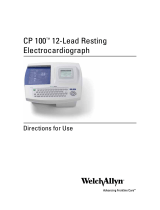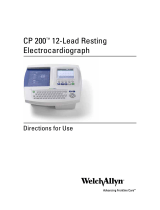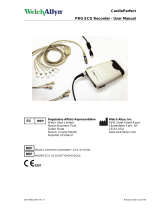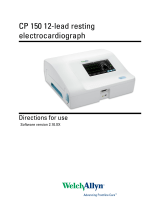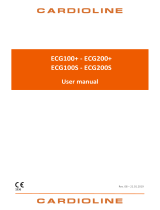Page is loading ...

CP 50™ and CP 50 Plus™ 12-lead
resting electrocardiograph
Directions for use

© 2016 Welch Allyn. All rights are reserved. To support the intended use of the product described in this publication,
the purchaser of the product is permitted to copy this publication, for internal distribution only, from the media
provided by Welch Allyn. No other use, reproduction, or distribution of this publication, or any part of it, is permitted
without written permission from Welch Allyn.
Welch Allyn assumes no responsibility for any injury to anyone, or for any illegal or improper use of the product, that
may result from failure to use this product in accordance with the instructions, cautions, warnings, or statement of
intended use published in this manual.
Welch Allyn is a registered trademark of Welch Allyn, Inc. CP 50, CP 50 Plus, and CardioPerfect are trademarks of
Welch Allyn, Inc.
PDI and Sani-Cloth are registered trademarks of PDI, Inc. CaviWipes is a trademark of Metrex Research Corporation.
Patent information
For patent information, please visit
http://www.welchallyn.com/patents.
Software in this product is copyright Welch Allyn or its vendors. All rights are reserved. The software is protected by
United States of America copyright laws and international treaty provisions applicable worldwide. Under such laws,
the licensee is entitled to use the copy of the software incorporated within this instrument as intended in the
operation of the product in which it is embedded. The software may not be copied, decompiled, reverse-engineered,
disassembled or otherwise reduced to human-perceivable form. This is not a sale of the software or any copy of the
software; all right, title and ownership of the software remains with Welch Allyn or its vendors.
For information about any Welch Allyn product, contact your local Welch Allyn representative:
http://
www.welchallyn.com/en/other/contact-us.html.
105487
This manual applies to 901048 ELECTROCARDIOGRAPH
DIR 80020944, Ver. A.
Revision date: 2016-06
Welch Allyn Limited
Navan Business Park
Dublin Road
Navan, County Meath
Republic of Ireland
www.welchallyn.com

Contents
Introduction ............................................................................................. 1
About this document ........................................................................................... 1
Intended use ........................................................................................................ 1
Indications for use ................................................................................................ 1
Description ........................................................................................................... 1
About the test types ............................................................................................ 2
Features ............................................................................................................... 3
Configuration options ........................................................................................... 4
Symbols ............................................................................................................... 5
General warnings ................................................................................................. 8
General cautions ................................................................................................ 10
Setup ...................................................................................................... 13
Connecting the patient cable ............................................................................. 13
Loading the thermal paper ................................................................................. 14
Powering the electrocardiograph ....................................................................... 16
About the menu ................................................................................................. 17
Viewing or changing the settings ....................................................................... 17
Viewing the device information ......................................................................... 17
Verifying proper operation .................................................................................. 18
Connecting to an external USB printer (optional - available with CP 50 Plus
only) ................................................................................................................... 19
Connecting to a CardioPerfect workstation (optional, available with CP 50 Plus
only) ................................................................................................................... 19
ECG tests ................................................................................................ 23
Attaching the leads to the patient ...................................................................... 23
Electrode locations ............................................................................................. 25
Performing an ECG test ..................................................................................... 27
Administrative tasks .............................................................................. 29
Turning the security option on or off (optional - available with CP 50 Plus
only) ................................................................................................................... 29
Managing the user list (optional - available with CP 50 Plus only) ..................... 29
Turning the audit trail on or off (optional - available with CP 50 Plus only) ........ 30
Managing the worklist (optional - available with CP 50 Plus only) ..................... 30
Managing the test directory ............................................................................... 31
Maintenance .......................................................................................... 33
Cleaning the equipment ..................................................................................... 33
Inspecting the equipment .................................................................................. 34
Testing the electrocardiograph .......................................................................... 34
Replacing the battery ......................................................................................... 34
iii

Replacing the AC fuses ...................................................................................... 36
Storing the equipment ....................................................................................... 36
Discarding the equipment .................................................................................. 36
Troubleshooting .................................................................................... 37
Lead-quality problems ........................................................................................ 37
System problems ............................................................................................... 40
Limited warranty ................................................................................................ 41
Service policy ..................................................................................................... 42
Specifications ........................................................................................ 43
Guidance and manufacturer’s declarations ........................................ 47
EMC compliance ................................................................................................ 47
Emissions and immunity information ................................................................. 47
Accessory list ......................................................................................... 51
iv Contents CP 50™ and CP 50 Plus™ 12-lead resting electrocardiograph

Introduction
About this document
This document is written for clinical professionals with a working knowledge of medical
procedures and terminology required for monitoring cardiac patients.
Before using the electrocardiograph for clinical applications — or before setting up,
configuring, troubleshooting, or servicing the electrocardiograph — you must read and
understand this document and all other information that accompanies the
electrocardiograph and related options or accessories.
Intended use
The Welch Allyn electrocardiography products (subject devices) are intended for use by
trained operators in health facilities. The subject devices provide the following diagnostic
functions:
•
Acquiring, viewing, storing, and printing ECG waveforms using ECG front-end
modules (patient cables) and associated accessories that provide signal acquisition
for up to twelve (12) leads of patient ECG waveforms through surface electrodes
adhered to the body.
• Using optional algorithms to generate measurements, data presentations, graphical
presentations, and interpretative statements on an advisory basis. These are
presented for review and interpretation by the clinician based upon knowledge of the
patient, the result of physical examination, the ECG tracings, and other clinical
findings.
Indications for use
The electrocardiograph is one of the tools that clinicians use to evaluate, diagnose, and
monitor patient cardiac function.
The 12-lead ECG interpretive algorithm provides a computer-generated analysis of
potential patient cardiac abnormalities which must be confirmed by a physician with
other relevant clinical information.
Description
• The electrocardiograph is not suited for direct cardiac application.
• The electrocardiograph allows users to perform 12-lead ECG measurements and
analysis.
• The electrocardiograph supports STAT, Auto, and Rhythm test types.
1

• The electrocardiograph provides the ability to print test records on an internal printer.
• The electrocardiograph provides the ability to send test records and analysis directly
to an electronic medical records (EMR) system.
• The electrocardiograph allows storage of test records in device memory, external
storage media, and external software applications.
• The electrocardiograph allows users to enter patient demographic data into the
electrocardiograph memory to be recalled for a test later that day.
About the test types
Auto ECG
A report typically showing a 10-second acquisition of 12 leads of ECG information combined with
patient data, measurements, and optional interpretation. Auto ECGs can be saved to the
electrocardiograph’s test directory or to a USB mass-storage device. In CP 50 Plus models, auto ECGs
can also be sent to a Welch Allyn CardioPerfect workstation.
Auto ECG report example
Stat ECG
An auto ECG that starts instantly without waiting for you to enter patient data or adjust the
waveforms.
WARNING To avoid the risk of associating reports with the wrong patients, make
sure that each test identifies the patient. Do not save a test to the patient record
without patient identification associated with the report.
Rhythm ECG
A continuous, real-time printout of rhythm strips with a user-defined lead configuration. Rhythm ECGs
are printouts only. They cannot be saved.
Rhythm ECG report example
2 Introduction CP 50™ and CP 50 Plus™ 12-lead resting electrocardiograph

Features
Pacemaker detection
The software detects the possible presence of a pacemaker. If you confirm that the
patient has a pacemaker, the ECG report includes no interpretation, and it indicates that
a pacemaker was detected.
Automatic ECG interpretation (optional)
The optional MEANS interpretation algorithm, developed by the University of Rotterdam
in the Netherlands, provides automatic analysis of ECG tests. For more information, see
the MEANS Physicians’ Manual or the PEDMEANS Physicians’ Manual on the CD that
came with your electrocardiograph. The MEANS algorithm is used for adult patients 18
years and older. The PEDMEANS algorithm is used for pediatric patients from 1 day
through 17 years old.
WARNING A computer-generated interpretation cannot replace sound
medical reasoning by a trained professional. Therefore, a physician should
always review the interpretation.
CAUTION Check for the presence of a pacemaker before using ECG with
interpretation.
CP 50 Plus (optional)
The CP 50 Plus consists of the CP 50 device and an optional connectivity feature that is
enabled with a software activation code.
Directions for use Introduction 3

Configuration options
The device is available in multiple configurations. Use the following to identify a
configuration:
[Device][Feature]-[Cable][Language][PowerCord]
Position Description
[Device] Four characters that indicate the device: CP50.
[Feature]
One or two characters that indicates the added feature:
•
Blank: A basic feature.
•
A: Includes automatic ECG interpretation.
•
P: Includes connectivity.
•
AP: Includes automatic ECG interpretation and connectivity.
[Cable]
A number that specifies the cable type included with the device:
•
1: AHA ECG cable with disposable electrodes.
•
2: IEC ECG cable with disposable electrodes.
•
3: AHA ECG cable with reusable electrodes.
•
4: IEC ECG cable with reusable electrodes.
[Language] Two characters that indicate the language of the manual included with your device:
Code Language Code Language
BR
DA
DE
EN
ES
FR
IT
NL
Brazilian Portuguese
Danish
German
English
Spanish
French
Italian
Dutch
NO
PL
PT
RU
SV
VI
ZH
Norwegian
Polish
Portuguese
Russian
Swedish
Vietnamese
Simplified Chinese
[PowerCord] One number that indicates the power cord packaged with the device.
No. Description No. Description
1
2
3
4
5
North America
Europe
Israel
United Kingdom
Switzerland
6
7
8
9
Australia
China
Denmark
South Africa
4 Introduction CP 50™ and CP 50 Plus™ 12-lead resting electrocardiograph

Symbols
Documentation symbols
WARNING The warning statements in
this manual identify conditions or
practices that could lead to illness, injury,
or death.
CAUTION The caution statements in this
manual identify conditions or practices
that could result in damage to the
equipment or other property, or loss of
data. This definition applies to both
yellow and black and white symbols.
Consult directions for use (DFU). A copy
of the DFU is available on this website. A
printed copy of the DFU can be ordered
from Welch Allyn for delivery within 7
calendar days.
Operation symbols
Power on/standby
Search
Auto ECG Rhythm ECG
Accept Close/Cancel
Previous Next
Help Menu
Backspace
Directions for use Introduction 5

Power symbols
(LED off) No AC power is present Battery absent or faulty
(LED green) AC power is present, and
battery is charging. (LED amber) AC
power is present, and battery is charging.
Battery is charged to the indicated level
Alternating current Battery is charging
Dangerous voltage Battery door
Fuse Rechargeable battery
Protective earth Nonionizing electromagnetic radiation
Equipotential terminal Lithium ion
Connectivity symbols
USB
Ethernet (RJ-45 )
Shipping, storing, and environment symbols
This end up
Keep dry
Fragile Humidity limitation
Temperature limits Atmospheric pressure limitation
6 Introduction CP 50™ and CP 50 Plus™ 12-lead resting electrocardiograph

Separate the battery from other
disposables for recycling
Recycle
Separate the device from other
disposables for recycling
See www.welchallyn.com/weee.
China RoHS
Miscellaneous symbols
Heartbeats per minute
Hot surface. Do not touch.
Manufacturer Date of manufacture
Defibrillation-proof Type CF applied part Serial number
Product identifier Batch code
Reorder number Global Trade Item Number
Do not reuse Software activation code
Meets essential requirements of
European Medical Device Directive
93/42/EEC
Directions for use Introduction 7

General warnings
Warnings indicate conditions or practices that could lead to illness, injury, or death.
Warnings related to the environment
WARNING To avoid a possible explosion, do not use the
electrocardiograph in the presence of flammable anesthetics: mixtures
containing air, oxygen, or nitrous oxide.
WARNING When transporting the electrocardiograph on a cart, tuck the
patient cable away from the wheels so that it does not present a hazard.
WARNING The power cord is considered the disconnect device for
isolating this equipment from supply mains. Do not position the equipment
so that it is difficult to reach or disconnect.
Warnings related to accessories and other equipment
WARNING For operator and patient safety, peripheral equipment and
accessories that can come in direct patient contact must be in compliance
with all appropriate safety, EMC, and regulatory requirements.
WARNING All signal input and output (I/O) connectors are intended for
connection of only devices complying with IEC 60601-1, or other IEC
standards (for example, IEC 60950), as appropriate to the device.
Connecting additional devices to the electrocardiograph might increase
chassis or patient leakage currents. To maintain operator and patient
safety, consider the requirements of IEC 60601-1-1. Measure the leakage
currents to confirm that no electric shock hazard exists. In the case of a
USB printer, the printer (non-medical electrical equipment) shall be situated
outside the patient environment (reference IEC 60601-1-1). The printer
used should be approved to the appropriate safety standard for non-
medical electrical equipment (IEC 60950, or its national variants), and use
of an isolation transformer is recommended. If there is a requirement for
the printer to be situated within the patient environment it is the
responsibility of the user to ensure that the system provides a level of
safety in compliance with IEC 60601-1 and 60601-1-1.
WARNING The electrocardiograph has not been designed for use with
high-frequency (HF) surgical equipment and does not protect against
hazards to the patient.
WARNING To avoid the risk of electric shock, this equipment must only
be connected to a supply mains with protective earth.
WARNING Defective batteries can damage the electrocardiograph.
Visually inspect the battery at least monthly. If the battery shows any signs
of damage or cracking, it must be replaced immediately and only with a
battery approved by Welch Allyn.
WARNING Improper disposal of batteries may create an explosion or
contamination hazard. Never dispose of batteries in refuse containers.
Always recycle batteries according to local regulations.
8 Introduction CP 50™ and CP 50 Plus™ 12-lead resting electrocardiograph

WARNING All signal input and output (SIP/SOP) connectors should not be
contacted by the patient directly or indirectly through the user during
operation.
WARNING Use only parts and accessories, including thermal paper, that
were supplied with the device and available through Welch Allyn. The use
of accessories other than those specified may result in degraded
performance or unsafe use of this device, including compromised
defibrillator protection, increased electromagnetic emissions or decreased
electromagnetic immunity.
Warnings related to using the electrocardiograph
WARNING This device captures and presents data reflecting a patient’s
physiological condition. When reviewed by a trained physician or clinician,
this data can be useful in determining a diagnosis. However, the data
should not be used as a sole means for determining a patient’s diagnosis or
prescribing treatment.
WARNING To avoid serious injury or death, take these precautions during
patient defibrillation:
• Avoid contact with the electrocardiograph, patient cable, and patient.
• Verify that the patient leads are properly connected.
• Place defibrillator paddles properly in relation to electrodes.
• After defibrillation, pull each patient lead out of the patient cable and inspect
the tips for charring (black carbon marks). If there is any charring, the patient
cable and individual leads must be replaced. If there is no charring, fully
reinsert the leads into the patient cable. (Charring can occur only if a lead is
not fully inserted into the patient cable before defibrillation.)
WARNING To prevent the spread of infection, take these precautions:
• Dispose of single-use components (for example, electrodes) after using
them once.
• Regularly clean all components that come in contact with patients.
• Avoid ECG testing for patients with open, infectious sores.
WARNING Avoid positioning any leads or cables so that they could easily
trip someone or become wrapped around a patient’s neck.
WARNING To ensure safe use of the device, follow the documented
maintenance procedures.
WARNING Only qualified service personnel should attempt to repair the
electrocardiograph. In case of a malfunction, call Technical Support.
WARNING Do not perform ST segment analysis on the ECG screen
display, since these ECG representations are scaled. Make manual
measurements of ECG intervals and magnitudes on printed ECG reports
only.
WARNING To maintain diagnostic accuracy and to comply with IEC
60601-02-51, do not scale (re size) when sending a saved ECG to an
external printer.
Directions for use Introduction 9

WARNING To avoid injury, do not touch the print head immediately after
printing. It might be hot.
WARNING No modification of this equipment is allowed.
WARNING To provide CF protection use only accessories approved by
Welch Allyn. Visit www.welchallyn.com. The use of any other accessories
can result in inaccurate patient data, can damage the equipment, and can
void your product warranty.
WARNING To avoid the risk of associating reports with the wrong
patients, make sure that each test identifies the patient. Do not save a test
to the patient record without patient identification associated with the
report.
General cautions
Cautions indicate conditions or practices that could damage the equipment or other
property.
CAUTION Federal US law restricts sale of the device identified in this
manual to, or on the order of, a licensed physician.
CAUTION When removing the electrocardiograph from storage, allow it to
thermally stabilize to surrounding environmental conditions before using it.
CAUTION To prevent possible damage, do not use sharp or hard objects
to press the touch screen or the buttons. Only use fingertips.
CAUTION Do not expose the patient cable to strong ultraviolet radiation.
CAUTION Do not pull or stretch the patient cable. Doing so could result in
mechanical or electrical failures. Form the patient cable into a loose loop
before storing.
CAUTION Avoid positioning the patient cable where it might get pinched,
stretched, or stepped on. Otherwise, measurements might no longer be
accurate, and repair might be necessary.
CAUTION Using the equipotential terminal for anything but grounding
purposes may contribute to damage of the device.
CAUTION Portable and mobile RF communications equipment can affect
the performance of the electrocardiograph.
CAUTION The electrocardiograph meets the Class A requirements of IEC
60601-1-2 regarding incidental emission of radio frequency interference. As
such it is suitable for use in commercial grade electrical environments. If
the electrocardiograph is used in residential grade electrical environments
and you experience incidental interference with other equipment that uses
radio frequency signals to operate, minimize the interference.
CAUTION Other medical equipment—including but not limited to
defibrillators, ultrasound machines, pacemakers, and other stimulators—
may be used simultaneously with the electrocardiograph. However, such
devices may disturb the electrocardiograph signal.
10 Introduction CP 50™ and CP 50 Plus™ 12-lead resting electrocardiograph

CAUTION The power cord must be disconnected from AC power before
cleaning, maintaining, transporting, or servicing.
CAUTION The requirements of AAMI EC11, Section 3.2.7.2, Frequency
and Impulse Response, for an impulse triangle waveform may be impacted
by up to 5 milliseconds of small amplitude dampened ringing immediately
after the impulse when the muscle filter (35 Hz) is turned on or a small
amplitude offset when the baseline filter (0.5 Hz) is turned on. These filters,
in any combination turned on or off, meet the AAMI requirements.
Measurements performed by the optional interpretation algorithm are
unaffected by any filter selections.
Note The entire patient cable, up to and including the electrodes, are considered
to be an Applied Part.
Directions for use Introduction 11

12 Introduction CP 50™ and CP 50 Plus™ 12-lead resting electrocardiograph

Setup
Connecting the patient cable
WARNING Do not allow the conductive parts of the patient cable,
electrodes, or associated connections of defibrillation-proof applied parts,
including the neutral conductor of the patient cable and electrodes, to
come into contact with other conductive parts, including earth ground.
Otherwise, an electrical short might result, risking electric shock to patients
and damage to the device.
WARNING To avoid injury to the patient or damage to the device, never
plug patient leads into any other device or wall outlet.
WARNING To provide CF protection use only accessories approved by
Welch Allyn. Visit www.welchallyn.com. The use of any other accessories
can result in inaccurate patient data, can damage the equipment, and can
void your product warranty.
CAUTION Always connect the patient cable and the leads properly during
defibrillation. Otherwise, the connected leads could be damaged.
13

Loading the thermal paper
The electrocardiograph prints on z-fold thermal paper or roll thermal paper.
• Store the paper in a cool, dry, dark place.
• Do not expose it to bright light or UV sources.
• Do not expose it to solvents, adhesives, or cleaning fluids.
• Do not store it with vinyls, plastics, or shrink wraps.
To load z-fold thermal paper
14 Setup CP 50™ and CP 50 Plus™ 12-lead resting electrocardiograph

To load a roll of thermal paper
Directions for use Setup 15

Powering the electrocardiograph
The electrocardiograph runs on AC or battery power. Plug the electrocardiograph into AC
power as often as possible so that the built-in charger can keep the battery charged.
Regardless of the battery condition, you can use the electrocardiograph whenever it is
plugged in.
WARNING When you use AC power, always plug the electrocardiograph
into a hospital-grade outlet to avoid the risk of shock.
WARNING If the integrity of the building’s safety ground is in doubt,
operate this device on battery power to avoid the risk of shock.
To power up or power down
Press .
16 Setup CP 50™ and CP 50 Plus™ 12-lead resting electrocardiograph
/

